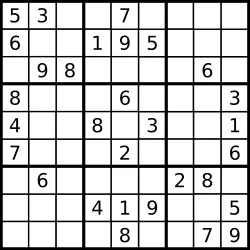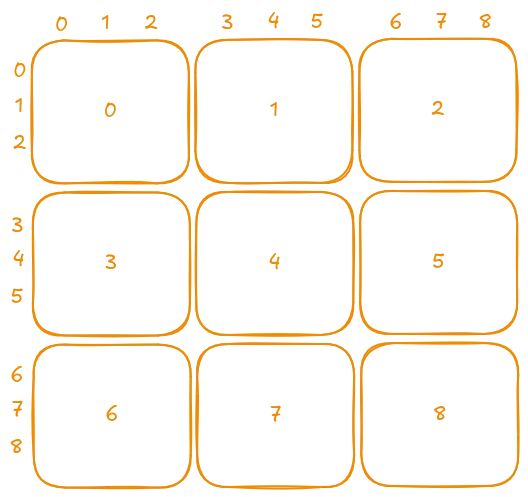36. Valid Sudoku
Description
Determine if a 9 x 9 Sudoku board is valid. Only the filled cells need to be validated according to the following rules:
- Each row must contain the digits
1-9without repetition. - Each column must contain the digits
1-9without repetition. - Each of the nine
3 x 3sub-boxes of the grid must contain the digits1-9without repetition.
Note:
- A Sudoku board (partially filled) could be valid but is not necessarily solvable.
- Only the filled cells need to be validated according to the mentioned rules.
Examples
Example 1:

-
Example 1:
-
Input:
board = [["5","3",".",".","7",".",".",".","."],["6",".",".","1","9","5",".",".","."],[".","9","8",".",".",".",".","6","."],["8",".",".",".","6",".",".",".","3"],["4",".",".","8",".","3",".",".","1"],["7",".",".",".","2",".",".",".","6"],[".","6",".",".",".",".","2","8","."],[".",".",".","4","1","9",".",".","5"],[".",".",".",".","8",".",".","7","9"]] -
Output::
true
-
-
Example 2:
-
Input:
board = [["8","3",".",".","7",".",".",".","."],["6",".",".","1","9","5",".",".","."],[".","9","8",".",".",".",".","6","."],["8",".",".",".","6",".",".",".","3"],["4",".",".","8",".","3",".",".","1"],["7",".",".",".","2",".",".",".","6"],[".","6",".",".",".",".","2","8","."],[".",".",".","4","1","9",".",".","5"],[".",".",".",".","8",".",".","7","9"]] -
Output::
false -
Explanation:: Same as Example 1, except with the 5 in the top left corner being modified to 8. Since there are two 8’s in the top left 3x3 sub-box, it is invalid.
-
Constraints
board.length == 9board[i].length == 9board[i][j]is a digit1-9or'.'
Test
#[cfg(test)]mod tests { use super::*;
// Helper function to convert a 2D array of &str into Vec<Vec<char>> fn board_from_str(board: &[&[&str; 9]; 9]) -> Vec<Vec<char>> { board .iter() .map(|row| row.iter().map(|&s| s.chars().next().unwrap()).collect()) .collect() }
#[test] fn test_valid_sudoku() { let board = board_from_str(&[ &["5","3",".",".","7",".",".",".","."], &["6",".",".","1","9","5",".",".","."], &[".","9","8",".",".",".",".","6","."], &["8",".",".",".","6",".",".",".","3"], &["4",".",".","8",".","3",".",".","1"], &["7",".",".",".","2",".",".",".","6"], &[".","6",".",".",".",".","2","8","."], &[".",".",".","4","1","9",".",".","5"], &[".",".",".",".","8",".",".","7","9"], ]); assert!(is_valid_sudoku(board)); }
#[test] fn test_invalid_sudoku_duplicate_in_row() { // Duplicate "8" in the first row let board = board_from_str(&[ &["8","3",".",".","7",".",".",".","8"], &["6",".",".","1","9","5",".",".","."], &[".","9","8",".",".",".",".","6","."], &["8",".",".",".","6",".",".",".","3"], &["4",".",".","8",".","3",".",".","1"], &["7",".",".",".","2",".",".",".","6"], &[".","6",".",".",".",".","2","8","."], &[".",".",".","4","1","9",".",".","5"], &[".",".",".",".","8",".",".","7","9"], ]); assert!(!is_valid_sudoku(board)); }
#[test] fn test_invalid_sudoku_duplicate_in_column() { // Duplicate "6" in the first column let board = board_from_str(&[ &["5","3",".",".","7",".",".",".","."], &["6",".",".","1","9","5",".",".","."], &["6","9","8",".",".",".",".","6","."], &["8",".",".",".","6",".",".",".","3"], &["4",".",".","8",".","3",".",".","1"], &["7",".",".",".","2",".",".",".","6"], &[".","6",".",".",".",".","2","8","."], &[".",".",".","4","1","9",".",".","5"], &[".",".",".",".","8",".",".","7","9"], ]); assert!(!is_valid_sudoku(board)); }
#[test] fn test_invalid_sudoku_duplicate_in_sub_box() { // Duplicate "9" in the top left 3x3 box let board = board_from_str(&[ &["5","3","9",".","7",".",".",".","."], &["6",".",".","1","9","5",".",".","."], &[".","9","8",".",".",".",".","6","."], &["8",".",".",".","6",".",".",".","3"], &["4",".",".","8",".","3",".",".","1"], &["7",".",".",".","2",".",".",".","6"], &[".","6",".",".",".",".","2","8","."], &[".",".",".","4","1","9",".",".","5"], &[".",".",".",".","8",".",".","7","9"], ]); assert!(!is_valid_sudoku(board)); }
#[test] fn test_valid_sudoku_alternate() { // Another valid sudoku board example (could be a different valid configuration) let board = board_from_str(&[ &[".",".",".",".",".",".",".",".","."], &[".",".",".",".",".",".",".",".","."], &[".",".",".",".",".",".",".",".","."], &[".",".",".",".",".",".",".",".","."], &[".",".",".",".",".",".",".",".","."], &[".",".",".",".",".",".",".",".","."], &[".",".",".",".",".",".",".",".","."], &[".",".",".",".",".",".",".",".","."], &[".",".",".",".",".",".",".",".","."], ]); // An empty board is considered valid as no rules are broken. assert!(is_valid_sudoku(board)); }
#[test] fn test_invalid_sudoku_multiple_errors() { // Board with multiple errors: duplicate in row and column let board = board_from_str(&[ &["5","3",".",".","7",".",".","3","."], // duplicate "3" in row &["6",".",".","1","9","5",".",".","."], &[".","9","8",".",".",".",".","6","."], &["8",".",".",".","6",".",".",".","3"], &["4",".",".","8",".","3",".",".","1"], &["7",".",".",".","2",".",".",".","6"], &[".","6",".",".",".",".","2","8","."], &[".",".",".","4","1","9",".",".","5"], &[".",".",".",".","8",".",".","7","9"], ]); assert!(!is_valid_sudoku(board)); }}Prototype
pub fn is_valid_sudoku(board: Vec<Vec<char>>) -> bool { todo!()}Solutions
Bruteforce & Bitwise
I like to present brute force solutions because they are simpler and help in understanding the problem. However, in this case, I believe the HashSet solution is much simpler.
There is also another solution using bitwise operations to reduce the Space Complexity to O(n), I’ll do it later.
Hash Set
We should divide the problem into smaller pieces; we should not try to solve everything at once. Let’s start with rows and columns. We need to check if all elements in each row and column are unique.
Rows And Columns

One of the most efficient ways to do this is to use a HashSet. Since we plan to use a hash set, we need another data structure to store a hash set for each row and each column. We can use vectors, as it is easy to reference each hash set by its index.
pub fn is_valid_sudoku(board: Vec<Vec<char>>) -> bool { const GRID_SIZE: usize = 9; let mut rows = vec![HashSet::new(); GRID_SIZE]; let mut columns = vec![HashSet::new(); GRID_SIZE];
todo!()}Then, we iterate over the two-dimensional array and insert each element into the appropriate hash set. The insert method returns false if the element is already present in the hash set—meaning that a duplicate exists in that row or column—and we can immediately return false. According to the description, the initial array contains either '.' or ASCII digits. Therefore, when we encounter a '.', we do nothing, otherwise, we insert the element.
pub fn is_valid_sudoku(board: Vec<Vec<char>>) -> bool { const GRID_SIZE: usize = 9; let mut rows = vec![HashSet::new(); GRID_SIZE]; let mut columns = vec![HashSet::new(); GRID_SIZE];
// iteration over all rows and columns for row in 0..GRID_SIZE { for col in 0..GRID_SIZE { // current char let c = board[row][col]; // do nothing if not ASCII digit if c == '.' { continue; } // if duplicate if !rows[row].insert(c) { return false; } // if duplicate if !columns[col].insert(c) { return false; } } } true}Internal Boxes
More than half of the work is already done, now we only need to handle the internal boxes. We can split these boxes and treat them similarly to rows or columns.

As we see in the picture, we can index each box from 0 to 8 and use the same vector of HashSet.
The only challenge is to calculate the correct index for each internal box. We can compute the index using the following formula:
(row / 3) * 3 + (col / 3)
Explanation:
- Dividing
rowby3groups the rows into three segments. - Dividing
colby3groups the columns into three segments. - Multiplying the row group by
3and adding the column group produces a unique index (from0to8) for each 3x3 box.
Implementation
pub fn is_valid_sudoku(board: Vec<Vec<char>>) -> bool { const GRID_SIZE: usize = 9; let mut rows = vec![HashSet::new(); GRID_SIZE]; let mut columns = vec![HashSet::new(); GRID_SIZE]; let mut boxes = vec![HashSet::new(); GRID_SIZE];
for row in 0..GRID_SIZE { for col in 0..GRID_SIZE { let c = board[row][col]; if c == '.' { continue; } if !rows[row].insert(c) { return false; } if !columns[col].insert(c) { return false; } let box_index = (row / 3) * 3 + (col / 3); if !boxes[box_index].insert(c) { return false; } } } true}- Time Complexity: O(n²) — Even though we perform a single pass through the board, we process n² elements.
- Space Complexity: O(n²)